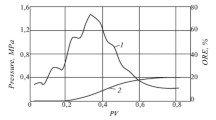The primary recovery of some heavy-oil reservoirs can reach relatively high values by using solution-gas-drive technology in which gas dissolved in heavy oil is released and drives the oil when the formation pressure drops below the bubble point. Rheological properties of foamy oil in porous media were studied using conditions of the Orinoco heavy-oil belt in Venezuela as examples. The relative mobilities of foamy and normal oil were compared in core flooding experiments. Improvement of the oil phase as a result of forming the foam structure was analyzed. The research results could be useful for understanding the mobility parameters of heavy oil and increasing the recovery efficiency in heavy-oil reservoirs.








Similar content being viewed by others
References
J. Wang, Yingzhong Yuan, Liehui Zhang, et al., J. Pet. Sci. Eng., 66, 69-74 (2009).
B. B. Maini, “Effect of Depletion Rate on Performance of Solution Gas Drive in Heavy Oil Systems,” SPE 81114, 2003.
C. Satik, C. Robertson, B. Kalpakci, et al., “A Study of Heavy Oil Solution Gas Drive for Hamaca Field: Depletion Studies and Interpretations,” SPE 86967, 2004.
D. D. Joseph, A. M. Kamp, and R. Baia, Int. I Multiphase Flow, 28, No. 10, 1659-1686 (2002).
D. D. Joseph, A. M. Kamp, T. Ko, et al., Int. I Multiphase Flow, 29, No. 9, 1489-1502 (2003).
S. Wang, Y. Huang, and F. Civian, J. Pet. Sci. Eng., 50, 83-101 (2006).
D. S. George, O. Hayat, and A. R. Kovscek, J. Pet. Sci. Eng., 46, 101-119 (2005).
F. Bauget and R. Lenormand, “Mechanisms of Bubble Formation by Pressure Decline in Porous Media: A Critical Review,” SPE 77457, 2002.
W. Hayduk and B. S. Minhas, Can. J. Chem. Eng., 60, 294-299 (1982).
I. Adil and B. B. Maini, “Role of Asphaltene in Foamy Oil Flow,” SPE 94786, 2005.
M. B. Geilikman, M. B. Dusseault, and F. A. L. Dulien, “Dynamic Effects of Foamy Fluid Flow in Sand Production Instability,” SPE 30251, 1995.
S. I. Kam and W. R. Rossen, “A Model for Foam Generation in Homogeneous Media,” SPE 77698, 2002.
Li Songyan, Zhaomin Li, Teng Lu, et al., Energy Fuels, 26, 6332-6342 (2012).
Ahmed Alshmakhy, “Foaminess and Viscosity Effects in Heavy Oil Flow,” in: Proceedings of Canadian Unconventional Resources Conference CURC, 11/2011.
D. D. Joseph, A. M. Kamp, et al., Int. J. Multiphase Flow, 29 1489-1502 (2003).
Acknowledgments
The work was financially supported by the Chinese National Natural Science Foundation (No. 51574200) and State Program for Support of Basic Research (No. 2008ZX050054).
Author information
Authors and Affiliations
Corresponding author
Additional information
Translated from Khimiya i Tekhnologiya Topliv Masel, No. 4, pp. 48 – 52, July – August, 2018.
Rights and permissions
About this article
Cite this article
Wang, J., Kang, B., Zhang, L. et al. Experimental Investigation of Rheological Properties of Foamy Oil. Chem Technol Fuels Oils 54, 467–475 (2018). https://doi.org/10.1007/s10553-018-0948-1
Published:
Issue Date:
DOI: https://doi.org/10.1007/s10553-018-0948-1




